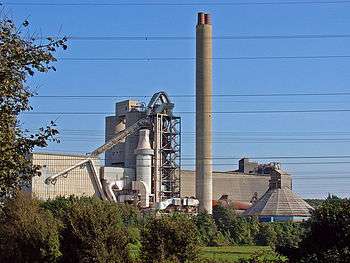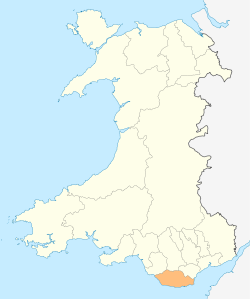Aberthaw Cement Works
Aberthaw Cement Works are cement works in the Vale of Glamorgan near the village of Aberthaw in Wales.

History
The Blue Lias limestone of Aberthaw was a source of hydraulic lime from early times, and it was made famous when it was selected by John Smeaton for the construction of the Eddystone Lighthouse.
The Aberthaw and Bristol Channel Portland Cement Company was established in 1912 by the Beynon family. The site at Aberthaw was chosen as it was near the necessary raw material, limestone and coal from the South Wales coalfield which was needed to heat the kilns. The works started in 1914 with two small wet process kilns with a production capacity of 120 tonnes per day each. A third wet kiln was added after the Second World War, and a fourth in 1957. This brought clinker capacity to 1200 tonnes per day.
In 1967, Kiln 5 (51.39743°N 3.393965°W) was installed. This was a much more efficient dry process kiln. The wet process kilns were decommissioned in 1974, and Kiln 6 - also a dry kiln - (51.397507°N 3.394326°W) was started in 1975. Kiln 6 remains in operation today.
In 1919 the company took over the nearby Aberthaw and Rhoose Point Portland and Lime Company. Blue Circle bought the two sites at Aberthaw and Rhoose in 1983. In 1987 Rhoose Works closed.
Lafarge Cement UK bought Blue Circle industries PLC in 2001, creating the largest cement maker in the world. Cement from the site is carried to destinations by Road and Rail (rail services being provided by Freightliner heavy haul and Colas Rail over the Vale of Glamorgan Line)
Watercolour artist Thomas Frederick Worrall worked for a few years at the cement works from when it was first opened.[1]
See also
- Aberthaw
- Aberthaw Power Station
- Aberthaw lime works
References
- See birth certificate of Bessie Worrall: Births in the sub-district of St Nicholas, in the county of Glamorgan no. 360, 1913, showing the occupation of Thomas F. Worrall as time keeper in cement works
